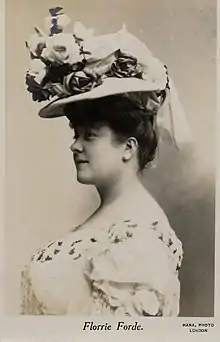Florrie Forde
Flora May Augusta Flannagan (16 August 1875 – 18 April 1940[1]), known professionally as Florrie Forde, was an Australian popular singer and music hall entertainer.[1] From 1897 she lived and worked in the United Kingdom. She was one of the most popular stars of the early 20th century music hall.
Florrie Forde | |
|---|---|
 Florrie Ford by George Henry Hana | |
| Born | Flora May Flannagan 16 August 1875 Fitzroy, Victoria, Australia |
| Died | 18 April 1940 (aged 64) Aberdeen, Scotland, United Kingdom |
| Nationality | Australian British |
| Occupation | Singer, entertainer |
| Known for | Chorus songs |
Notable work | "Hold Your Hands Out You Naughty Boy" |
| Spouse(s) |
|
Early life and career
Forde was born in Fitzroy, Victoria in 1875. She was the sixth of the eight children of Lott Flannagan, a stonemason, and Phoebe (née Simmons), who also had two children from a prior marriage. By 1878 her parents had separated and Phoebe married Thomas Ford, a theatrical costumier in 1888. Forde and some of her siblings were placed in a convent. At the age of sixteen, she ran away to live with an aunt in Sydney. When she appeared on the local music hall stage, she adopted her stepfather's surname but added an 'e'. One of her earliest vaudeville performances was as a singer in February 1892 at Polytechnic Music Hall in Pitt Street.[1] According to The Sydney Morning Herald's reviewer, at one such performance in January 1892, "[i]n the first part the vocalists were all well received, and several had to respond to encores. The serio-comic song by Miss Florrie Ford, 'Yes, You Are,' proved a great attraction."[2]
At the age of 21, in 1897, she left for London, and on August Bank Holiday 1897, she made her first appearances in London at three music halls – the South London Palace, the Pavilion and the Oxford – in the course of one evening. She became an immediate star, making the first of her many sound recordings in 1903 and making 700 individual recordings by 1936.
Forde had a powerful stage presence, and specialised in songs that had powerful and memorable choruses in which the audience was encouraged to join. She was soon drawing top billing, singing songs such as "Down at the Old Bull and Bush" and "Has Anybody Here Seen Kelly?". She appeared in the very first Royal Variety Performance in 1912. During World War I, her most famous songs were some of the best known of the period, including "Pack Up Your Troubles in Your Old Kit-Bag", "It's A Long Way To Tipperary" and "Take Me Back to Dear Old Blighty".
Marriage
On 2 January 1893 in Sydney, she married Walter Emanuel Bew, a 31-year-old police constable.[1] On 22 November 1905 at the register office, Paddington, London, as Flora Augusta Flanagan, spinster, she married Laurence Barnett (d.1934), an art dealer.[1][3]
Revue
Florrie Forde formed her own travelling revue in the 1920s. It provided a platform for new rising stars, the most famous being the singing duo of Flanagan and Allen.
Death and legacy
She collapsed and died from a cerebral haemorrhage, after singing for troops in Aberdeen, Scotland, on 18 April 1940; she was 64. The Anglo-Irish poet Louis MacNeice left a tribute to her in a poem, 'Death of An Actress', recalling how:
With an elephantine shimmy and a sugared wink
She threw a trellis of Dorothy Perkins roses
Around an audience come from slum and suburb
And weary of the tea-leaves in the sink.[1]
She is buried in Streatham Park Cemetery, London.[4]
National Film and Sound Archive
Florrie Forde's song Hold Your Hand Out Naughty Boy was added to the National Film and Sound Archive's Sounds of Australia registry in 2013.[5]
Selected songs
- "Down at the Old Bull And Bush"
- "She's a Lassie from Lancashire"
- "Oh! Oh! Antonio!"
- "Has Anybody Here Seen Kelly?"
- "Flanagan"
- "Take Me Back to Dear Old Blighty"
- "Hold Your Hand Out, Naughty Boy"
- "Good-bye-ee!"
- "A Bird in a Gilded Cage"
- "Daisy Bell"
- "I Do Like To Be Beside The Seaside"
- "Now I Have to Call him Father"
- "Pack Up Your Troubles in Your Old Kit Bag"
- "It's A Long Way To Tipperary"
Selected filmography
- My Old Dutch (1934)
- Say It With Flowers (1934)
References
- Brownrigg, Jeff. "Biography – Forde, Florrie (1875–1940)'". Australian Dictionary of Biography, Supplementary Volume. Melbourne University Press. pp. 129–130. Retrieved 7 July 2017.
- "The Sydney Morning Herald". The Sydney Morning Herald (16, 799). 25 January 1892. p. 5. Retrieved 7 July 2017 – via National Library of Australia.
- Register of Births, Marriages & Deaths, Paddington, Dec Qtr 1905, Vol 1a, page 194
- Music Hall burials (Arthur Lloyd) accessed 29 October 2007
- National Film and Sound Archive: Sounds of Australia.
External links
- Florrie Forde – you can hear her sing 'I Do Like To Be Beside The Seaside'
- Halt ! Who goes there ? by Florrie Forde on YouTube – you can hear her sing 'Halt ! Who goes there ?'
- Eight digitally restored recordings to listen to or download.
- Florrie Forde singing "Has Anybody Seen Kelly" on YouTube
- findagrave(2 memorials)